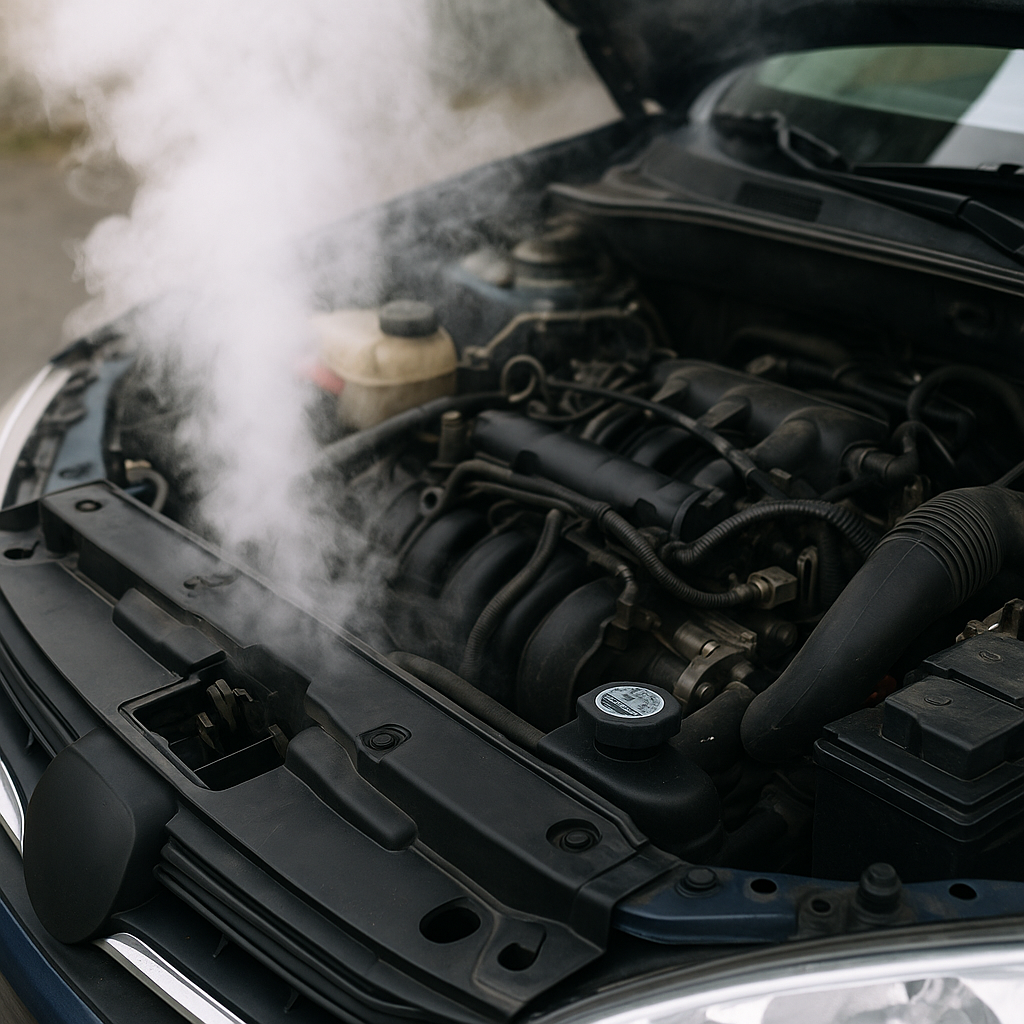Engine overheating can happen all year round, but during hot UK summers and long journeys it becomes more likely and more dangerous. With a little preparation, regular checks and calm action, you can avoid breakdowns and costly engine damage. Here’s your guide.
1. Understand How Your Cooling System Works
- Engine coolant circulates through galleries in the engine block and head, absorbing heat.
- It is pumped through the radiator, where airflow removes heat, before returning to the engine.
- The thermostat regulates coolant flow, opening when the engine reaches working temperature.
- A fan boosts cooling when the car is stationary or moving slowly.
Knowing how the system works helps you catch early warning signs.
2. Preventive Maintenance: Your First Line of Defence
- Check coolant levels regularly, every few months and before long journeys. Use a 50:50 mix of manufacturer-recommended coolant and distilled water.
- Inspect hoses, radiator, belts, and engine seals for wear or leaks.
- Watch for leaks under your car, which could be signs of coolant escaping.
- Service the coolant system as per the manufacturer schedule, typically every three to five years or 40,000 miles, and pressure-test the cap.
- Maintain engine oil and battery health. Good oil prevents heat build-up and a strong battery ensures system stability.
3. Summer Ready Checks
- Park in shade or use sunshades to minimise heat soak.
- Test your air-conditioning regularly to ensure the system and fans are working. A faulty air-conditioning unit may indicate deeper issues.
- Have your cooling system and air-conditioning checked before warmer months begin.
4. Smart Driving Behaviours
- Keep a close eye on your dashboard temperature gauge and warning lights.
- In congested traffic, shift to neutral or park, and rev the engine to around 1,500 RPM to drive coolant and air through the radiator.
- Avoid prolonged drives in steep conditions, carrying heavy loads or high-speed cruising in hot ambient temperatures.
- If overheating signs emerge and you cannot stop, switch off the air-conditioning and turn the heating to full. This draws heat away from the engine.
5. When Overheating Happens: Step by Step
- Pull over safely and never ignore the warning signs.
- Switch off the engine, turn off the air-conditioning, and turn on the heater to shift heat.
- Allow at least 15 to 30 minutes for the engine to cool.
- Never open the radiator cap immediately. Wait until the pressure has dropped to avoid burns.
- Inspect coolant level once cool and top up with coolant or warm water if needed.
- Watch for leaks under the car, as a puddle may signal hose or seal damage.
- Restart carefully while monitoring the gauge. If it overheats again, pull over and call for roadside assistance.
- Do not drive onward with an overheating engine, as the risk of head gasket failure or a seized engine is high.
6. Build an Emergency Roadside Kit
Keep these essentials in your car year round:
| Item | Purpose |
|---|---|
| Extra coolant and distilled water | For topping up a cool engine |
| Funnel and gloves | To safely add fluids |
| Tow rope and hazard warning triangle | For emergency stops |
| Torch, high visibility vest and first aid kit | For roadside safety |
| Breakdown cover and contact numbers | For quick recovery support |
| Sunglasses and water bottles | To stay comfortable in heat |
7. Know the Key Warning Signs
- Dashboard gauge in red or warning light illuminated
- Steam or smoke from under the bonnet
- Smell of sweet coolant or burning oil
- Coolant leaks detected visually
- Strange engine noises such as ticking caused by overheating
Spotting these early can save you from more serious repairs.
Summary: Keep Calm, Stay Cool
Regular maintenance such as checking coolant, hoses, belts, oil and the coolant system minimises overheating risk.
Smarter driving such as monitoring the dashboard, using the heating trick and avoiding stress on the engine helps keep temperatures down.
Safe procedures if overheating occurs include stopping, waiting, carefully topping up and calling for assistance.
Be prepared by carrying a coolant refill kit and essentials to manage a roadside emergency.
By following these steps, you will reduce the risk of overheating, stay safer on the road and avoid unnecessary repair bills. Proper care now means smooth motoring later with your engine staying cool, whatever the temperature.

